Breadcrumb
Dr Clare Rees-Zimmerman receives OxWiChem poster prize
On 4 November the University of Oxford’s Department of Chemistry hosted its second-ever Oxford Women in Chemistry (OxWiChem) Day. Among the attendees this year was Christ Church Junior Research Fellow Dr Clare Rees-Zimmerman, who was awarded a prize for the best physical and theoretical chemistry poster.
A year on from the inaugural event, the 2024 OxWiChem Day was a celebration of the recent achievements and research contributions of Oxford’s female chemists. Sponsored jointly by Oxford’s Department of Chemistry and the Royal Society of Chemistry, the half-day symposium featured a number of keynote talks, flash presentations and discussions from women chemists representing various chemistry divisions and differing career stages, followed by poster displays, networking and refreshments.
The OxWiChem Committee, which is responsible for organising the annual symposium, was particularly impressed by Dr Rees-Zimmerman’s poster entitled ‘Measuring depletion interactions’. The poster sets out some of the work Dr Rees-Zimmerman has completed in collaboration with Dirk Aarts, Professor of Chemistry at Christ Church and head of the Oxford Colloid Group, concerning microscopic particles dispersed in fluid known as ‘colloids’. Colloidal particles measure between 1 nanometre (1×10−9m) and 1 micrometre (1×10−6m) in diameter, and the latest project of Dr Rees-Zimmerman and Professor Aarts investigates apparent attractive interactions between larger colloids in the presence of depletants – smaller particles that are excluded from being too close to the large particles. Polymers such as xanthan gum can act as depletants, and Dr Rees-Zimmerman’s celebrated poster delineates a new method she and Professor Aarts have developed for measuring such colloid–polymer depletion interactions.
Commenting on the success of the novel measurement technique, Dr Rees-Zimmerman remarked: ‘It’s exciting that the method works as a way to measure the depletion interaction, and so opens up the use of this method to analyse the interaction in more detail. It’s also interesting in itself that we can observe particles appearing to attract each other, just by adding in another component.’
The success of Dr Rees-Zimmerman and Professor Aarts’ technique represents a significant advance in their broader project of developing a method to infer the interaction potential between particles in dispersions, as a function of the distance between those particles. Through such a method, we can secure a better understanding of formulations – mixtures of substances designed for a specific purpose, such as toothpaste, shampoo and fertiliser – and become better able to improve them.
Dr Rees-Zimmerman was delighted to have the value of this research recognised: ‘I am really happy to have received this award – though I just as much enjoyed the opportunity to discuss my work with people from across the department, and learn what others are working on, too!’
Dr Rees-Zimmerman currently works in the Oxford Colloid Group, based in the Department of Physical and Theoretical Chemistry, with Christ Church’s Professor Dirk Aarts. Learn more about her research via her Christ Church profile.
Other Christ Church news



